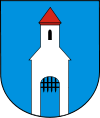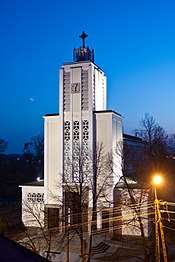Gąbin
Gąbin [ˈɡɔmbin] is a small town in Płock County, Masovian Voivodeship, Poland, with 4,230 inhabitants (2006). It is an ancient town, having been founded in the 13th century. The Warsaw radio mast, which stood near Gąbin, was the tallest structure in the world until its collapse in 1991.
Gąbin | |
|---|---|
Town Hall | |
 Coat of arms | |
 Gąbin | |
| Coordinates: 52°24′N 19°44′E | |
| Country | |
| Voivodeship | Masovian |
| County | Płock |
| Gmina | Gąbin |
| Established | 13th century |
| Town rights | before 1437 |
| Government | |
| • Mayor | Krzysztof Mieczysław Jadczak |
| Area | |
| • Total | 28.16 km2 (10.87 sq mi) |
| Population (2006) | |
| • Total | 4,137 |
| • Density | 150/km2 (380/sq mi) |
| Time zone | UTC+1 (CET) |
| • Summer (DST) | UTC+2 (CEST) |
| Postal code | 09-530 |
| Area code(s) | +48 24 |
| Car plates | WP |
| Website | gabin.pl |
History
Gabin was first mentioned in 1215, but a Slavic gord existed here long before that date, as in 1920, a coin minted by Boleslaw Chrobry was found in the market square. Gabin probably received town charter in 1322; in 1437 the charter was confirmed and expanded. Until the mid-15th century, it was part of the Duchy of Mazovia, and in 1462, it became seat of a county in Gostynin Land, Rawa Voivodeship. In the period known as Polish Golden Age, Gabin was famous for its cloth makers, it also was the seat of a starosta.
The period of prosperity ended during the Swedish invasion of Poland (1655 - 1660), when Gabin was ransacked and burned to the ground. The town stagnated for the next 150 years: in the 1820s, a number of German artisans settled here, and Gabin began its recovery, but the process was halted in the late 19th century, due to proximity of quickly developing industrial town of Zyrardow.
Jews of Gąbin
 Synagogue of Gabin (Gombin) destroyed by the nazis during World War II. Photo taken in 1833
Synagogue of Gabin (Gombin) destroyed by the nazis during World War II. Photo taken in 1833 Front of the Gabin Synagogue
Front of the Gabin Synagogue Old sketch of the Gabin (Gombin) Synagogue dated 1893.
Old sketch of the Gabin (Gombin) Synagogue dated 1893.
From its earliest days, Gąbin was a town of craftsmen of various trades, and her population contained a sizeable number of Jews. Competition and conflict between Jewish and the non-Jewish tradesmen is noted as early as 1576 when Sigismund III issued a decree prohibiting Jews from buying leather from the local peasants, allowing them to purchase leather only at the town market after completion of the morning mass at the town’s Catholic church. In 1582 a decree from Stephen Báthory further prevented Jews from buying hides and tallow in the town or its vicinity. During subsequent years, Jews were harassed at times, and forced to live in designated parts of the town, called the “quarter.”
Jews generally represented approximately half the population of the town. For example, in 1808, the town’s population consisted of 577 Jews out of a total population of 1,183. The census of 1827 counted 1,472 Jews out of a total population of 2,926. After World War I the 1921 census showed that of the total population of the town, at 5,777, there were 2,564 Jews living in the town.[1]

Before the onset of World War II, Gąbin was home to a very large Jewish population, around 2000, and housed one of the most remarkable old wooden synagogues of the entire region.[2] On September 7, 1939, Gąbin was occupied by the invading German Army, which burned down the wooden synagogue and rounded up the town’s Jewish population to dig trenches for protection against the Polish Army. In 1940, German police and SS murdered many Jews and tortured many others. In 1941, the Germans placed the Jewish population in a ghetto, and in 1942 about 500 were sent to labor camps. Later that year, the Germans rounded up the remaining hundreds of Jews and sent them to Chelmno where they were immediately gassed.[3] At war’s end, of the approximately 2,300 Jews that had resided in Gąbin (including about 250 sent there during the war, only about 212 survived, 180 having escaped to the Soviet occupied zone of Poland in September 1939, and 32 fleeing into the Polish countryside.[4][5]
The Jewish history of Gąbin was memorialized in Minna Packer's acclaimed documentary film Back To Gombin (2002)[6] as seen on United States and Israeli television, and in numerous international film festivals. Gombin is the name for the town in both Yiddish and German. The film is distributed by the National Center for Jewish Film.
Under communist rule
Between 1974 and 1991 the Warsaw radio mast in Konstantynów, a village belonging to Gąbin commune (gmina) was the tallest structure on earth. The tower was used to broadcast the programs of Polish Radio throughout Europe.[7] Because of fears that the tower's incredibly powerful radio waves might cause health problems, a large number of villagers who had once farmed the land directly under and around the tower were migrated to a block-style apartment building in the center of Gąbin, where many still reside today. The town has experienced a remarkable renaissance since the fall of Communism.
Notable inhabitants
Rajzel Żychlińsky, who was born in Gąbin in 1910 and attended grade school there, escaped to the Soviet-occupied part of Poland in September 1939, and was later recognized as a major writer of poetry in Yiddish.[8]
Education
Gąbin is home to a large high school of over 1,000 students with specialties in modern farming techniques, technical skills, and preparation for higher education. The school has been home to Peace Corps volunteers and has promoted foreign exchange visits with peers from Germany, Russia, and other countries.
Churches
Churches that support the local Catholic population include:
- Saint Nicholas, ul. Warszawska 4, Gabin, 09-530 PL[9]
Special events
- Gabin Tower Memorial Festival
References
- http://www.kirkuty.xip.pl/gabin.htm
- http://www.zchor.org/SYN.HTM
- http://www.zchor.org/indexgom.htm#genealogy
- http://www.kirkuty.xip.pl/gabin.htm
- Megargee, Geoffrey (2012). Encyclopedia of Camps and Ghettos. Bloomington, Indiana: University of Indiana Press. p. Volume II, 53-54. ISBN 978-0-253-35599-7.
- Packer, Minna (2002). Back to Gombin. Harry Kafka (editor). Waltham, Massachusetts: National Center for Jewish Film. ISBN 9781585873647. OCLC 237333892. The film "tells the story of a group of 50 children of survivors of Shoah, who return to their parents village in Poland in acts of reconciliation, healing and discovery."
- http://en.structurae.de/structures/data/index.cfm?ID=s0000672
- http://www.zchor.org/zychlinsky/biography.htm
- http://www.thecatholicdirectory.com/directory.cfm?fuseaction=display_site_info&siteid=170160
External links
- Official website
- Map of Gąbin
- Gombin Society active participant Ada Holtzman's personal web site and memoir to Gombin
- Jewish Community in Gąbin on Virtual Shtetl
| Wikimedia Commons has media related to Gąbin. |